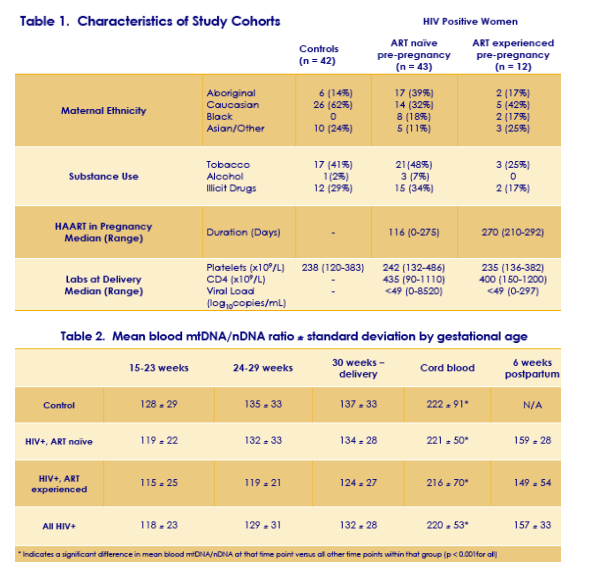 |
 |
 |
| |
Mitochondrial DNA Levels in Pregnancy Are Not Decreased in ARV-treated Women Compared to HIV- Controls
|
| |
| |
Reported by Jules Levin CROI Montreal 2009 Feb 8-12
Deborah Money*1,2, E Maan3, T Chaworth-Musters3, I Gadawski1, J Van Schalkwyk3, J Forbes3, H Cote1,2, and the HIV Perinatal Study Group
1Univ of British Columbia, Vancouver, Canada; 2Women`s Hlth Res Inst, Vancouver, Canada; and 3Children`s and Women`s Hlth Ctr of British Columbia, Vancouver, Canada
Background: Treatment with NRTI-containing HAART is standard of care for HIV+ pregnant women. NRTI therapy is known have to cause mitochondrial (mt) toxicity seen as mtDNA depletion and, if severe, clinical symptoms with hyperlactatemia. The study hypothesis was that there would be an exposure-dependent depletion of mtDNA, which may impair pregnancy outcomes..
Methods: In this prospective cohort study, blood cells mtDNA/nuclear DNA ratio were determined in HIV+ pregnant women and HIV- controls at 3 times in pregnancy-at delivery, in cord blood, and at 6 weeks post partum. Demographic, behavioral, and clinical parameters were collected. MtDNA content was measured in whole blood by real-time polymerase chain reaction (RT-PCR). HIV+ women who were on NRTI prior to pregnancy were analyzed separately from those who started HAART in pregnancy. Between-group comparisons and changes over time were examined using GEE.
Results: We enrolled 97 women (42 controls, 43 HIV+ starting HAART in pregnancy, and 12 exposed pre-pregnancy). NRTI consisted of zidovudine (AZT)/lamivudine (3TC) in all but 7, (3 stavudine [d4T]/3TC, 3 tenofovir [TDF]/3TC, 1 TDF/abacavir [ABC]) with most women also receiving nelfinavir (NFV) or kaletra. Of these, 84 had sufficient samples for the longitudinal analysis. There were no significant differences between groups (p >0.25) and no significant effects of covariates including; age, ethnicity, substance use, smoking, duration of HAART, and platelet count (all p >0.100). Differences over time were seen in all groups, with mtDNA rising significantly during pregnancy (p = 0.031). Cord blood mtDNA levels were significantly higher than any time point in pregnancy (p <0.001)
Conclusions: There was no demonstrable decrease in mtDNA in pregnant women exposed to NRTI-containing HAART in pregnancy than in controls. There was an increase in mtDNA in all groups as pregnancy progressed and substantively in cord blood that appears to be physiologic. These reassuring data for HAART use in pregnancy needs to be followed up with further long-term evaluation.

|
| |
|
 |
 |
|
|